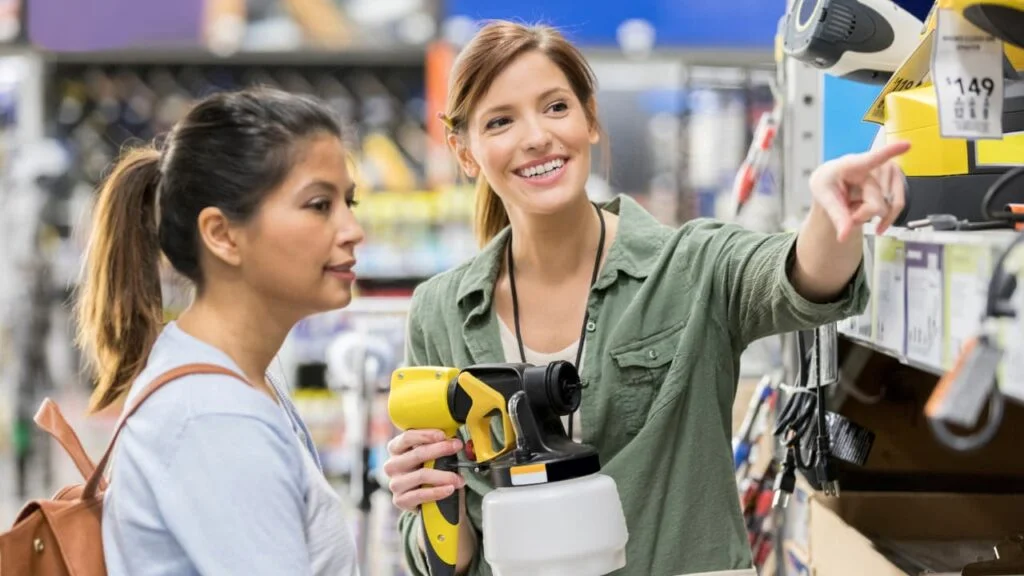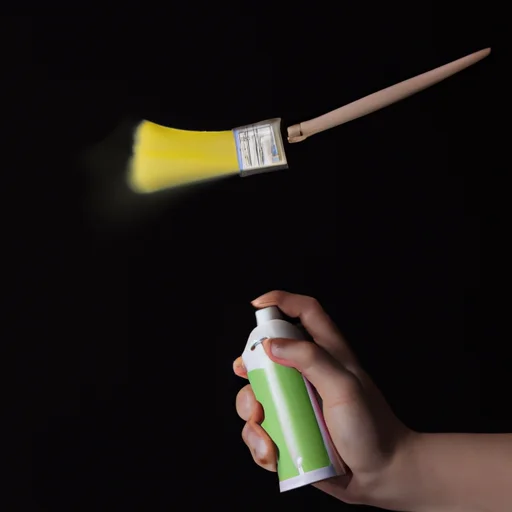Ladies and gentlemen, let us embark on a journey surrounded by the mesmerizing world of airless sprayers. Today, we explore the alluring question, “Do airless sprayers give a better finish?” Grab your paintbrushes, for we are about to plunge into the captivating realm of flawless painting perfection. Together, we will unravel the secrets and unveil the hidden potential of these innovative tools. Prepare to be amazed as we discover the true power of airless sprayers and their undeniable ability to transform any surface into a work of art. So, let us begin this adventure, where creativity and precision intertwine, and where the finish speaks volumes.
Do Airless Sprayers Give A Better Finish?
Table of Contents
Types of Sprayers
Airless Sprayers
Airless sprayers are a type of paint sprayer that operate by pumping paint directly from the paint container, through a hose, and out through a small opening in the spray gun. The paint is atomized into fine particles, creating a smooth and even finish. Airless sprayers are known for their efficiency, speed, and versatility.
Air Spray Guns
Air spray guns, on the other hand, use compressed air to atomize the paint and propel it onto the surface. The paint is mixed with air to create a fine mist, which is then sprayed onto the surface. Air spray guns are commonly used in automotive refinishing and other applications where a high-quality finish is desired.
HVLP Sprayers
HVLP stands for High Volume Low Pressure. HVLP sprayers use a large volume of air at a low pressure to atomize the paint and create a smooth finish. HVLP sprayers are known for their ability to produce a high-quality finish with minimal overspray. They are often used for fine finishing work, such as painting furniture or cabinets.
Air Assist Airless Sprayers
Air assist airless sprayers combine the technology of airless sprayers and air spray guns. These sprayers use a combination of airless and air atomization to produce a fine finish with minimal overspray. Air assist airless sprayers are often used in industrial applications where a high-quality finish is required.
Advantages of Airless Sprayers
Efficiency
Airless sprayers are incredibly efficient, as they can cover large areas in a short amount of time. The high pressure and atomization rate allow for quick and even coverage, reducing the need for multiple coats.
Coverage
Airless sprayers are known for their ability to provide excellent coverage. The high pressure and atomization rate ensure that the paint is distributed evenly, resulting in a consistent and smooth finish.
Speed
Due to their high atomization rate and large coverage area, airless sprayers are significantly faster than other painting methods. Whether it’s a large surface area or multiple coats, airless sprayers can tackle the job in less time.
Versatility
Airless sprayers are highly versatile and can be used for a wide range of applications. Whether it’s interior walls, exterior walls, furniture, cabinetry, or even automotive painting, airless sprayers can handle it all.
No Clogging
One of the biggest advantages of airless sprayers is that they are less prone to clogging compared to other sprayers. The high-pressure system helps to prevent paint from drying or clogging the nozzle, ensuring a smooth and uninterrupted painting process.
Factors Affecting Finish
Surface Preparation
No matter which sprayer you choose, proper surface preparation is essential for achieving a better finish. Make sure the surface is clean, smooth, and free of any dust or debris before applying paint.
Paint Quality
The quality of the paint also plays a crucial role in the final finish. Using high-quality paint that is specifically formulated for spray application can make a significant difference in the overall result.
Technique
Applying paint with an airless sprayer requires some technique and practice. Holding the sprayer at the correct distance from the surface, maintaining a consistent speed, and using smooth and even strokes can help achieve a better finish.
Pressure and Flow Rate
Adjusting the pressure and flow rate of the sprayer is essential for achieving the desired finish. It may require some experimentation to find the right settings for the specific application, but it is worth the effort for a better finish.
Airless Sprayers vs Other Sprayers
Airless Sprayers vs Air Spray Guns
While air spray guns can produce a high-quality finish, they have some limitations compared to airless sprayers. Air spray guns tend to have more overspray, resulting in wasted paint and a messier work environment. Additionally, air spray guns require a compressor to operate, adding an additional cost and complexity to the setup.
Airless Sprayers vs HVLP Sprayers
HVLP sprayers are known for their ability to produce a high-quality finish with minimal overspray. However, they are typically slower than airless sprayers and may require multiple coats to achieve the same level of coverage. Additionally, HVLP sprayers often have smaller paint containers, which means more frequent refilling.
Airless Sprayers vs Air Assist Airless Sprayers
Air assist airless sprayers are a hybrid between airless sprayers and air spray guns. They combine the high speed and efficiency of airless sprayers with the fine finish and control of air spray guns. While air assist airless sprayers can produce a high-quality finish, they are generally more expensive and may not be necessary for every application.
Application Areas
Interior Walls
Airless sprayers are ideal for painting interior walls, especially in large spaces. Their efficiency and speed allow for quick coverage of large areas, making them a popular choice for contractors and homeowners alike.
Exterior Walls
When it comes to painting exterior walls, airless sprayers are an excellent choice. They can handle different types of exterior surfaces, including stucco, wood, and brick, with ease. With their ability to cover large areas quickly and evenly, airless sprayers are perfect for painting the exterior of homes or commercial buildings.
Furniture
Whether it’s refinishing old furniture or painting new pieces, airless sprayers are a great option. They provide a smooth and even finish, bringing new life to old furniture or adding a fresh coat of paint to new pieces.
Cabinetry
When it comes to painting kitchen cabinets or bathroom vanities, airless sprayers can save both time and effort. With their ability to provide a smooth and even finish, they can quickly transform the look of any cabinetry project.
Automotive
Airless sprayers are also used in automotive painting. They can handle the large surfaces of cars, trucks, and other vehicles with ease. With their ability to provide a smooth and even finish, airless sprayers are an excellent choice for automotive refinishing.
Tips for Achieving a Better Finish with Airless Sprayers
Choose the Right Tip Size
The size of the spray tip plays a crucial role in achieving a better finish. Different tip sizes are suitable for different applications and types of paint. It’s important to choose the right tip size for the specific project to ensure optimal coverage and finish.
Adjust the Pressure and Flow Rate
Properly adjusting the pressure and flow rate of the sprayer is essential for achieving a better finish. Experiment with different settings to find the right combination for the specific application. Adjusting the pressure and flow rate can help to prevent overspray, achieve a consistent finish, and minimize paint waste.
Maintain Proper Spraying Distance
Maintaining the correct spraying distance is vital for achieving a better finish. Holding the sprayer too close to the surface can result in a thick and uneven coat, while holding it too far away can cause the paint to dry before reaching the surface. Finding the right spraying distance is key to achieving a smooth and even finish.
Common Problems with Airless Sprayers
Overspray
Overspray is a common issue with airless sprayers, especially if the spraying distance or pressure is not properly adjusted. Overspray not only wastes paint but also creates a messy work environment. To minimize overspray, adjusting the pressure and flow rate of the sprayer, as well as maintaining the correct spraying distance, is crucial.
Orange Peel
Orange peel refers to an uneven texture on the painted surface, resembling the skin of an orange. It is typically caused by improper technique or incorrect pressure settings. Using a higher-quality paint, adjusting the pressure, and using smooth and even strokes can help minimize orange peel.
Paint Runs
Paint runs occur when too much paint is applied in one area, causing it to drip or sag. This can happen if the pressure or flow rate is set too high, or if the sprayer is held too close to the surface. Adjusting the pressure and flow rate and maintaining the correct spraying distance can help prevent paint runs.
Uneven Coating
Achieving an even coating with an airless sprayer requires proper technique and adjustment of the sprayer settings. Holding the sprayer at the correct distance, using smooth and even strokes, and adjusting the pressure and flow rate can help ensure an even and consistent finish.
Cost Considerations
Initial Investment
When considering airless sprayers, the initial investment is an important factor to take into account. Airless sprayers generally range in price depending on their quality and features. While there are more affordable options available, investing in a higher-quality sprayer can result in better performance and longevity.
Operating Costs
In addition to the initial investment, it’s essential to consider the operating costs of an airless sprayer. This includes factors such as paint consumption, maintenance, and potential repairs. High-quality paint and regular maintenance can help minimize operating costs and maximize the lifespan of the sprayer.
Maintenance and Cleaning
Flushing the System
Regularly flushing the system is essential for maintaining the performance and longevity of an airless sprayer. This involves running a cleaning solution or water through the sprayer to remove any paint residue or debris. Flushing the system after each use and before switching between different types of paint can help prevent clogging and ensure a smooth painting process.
Replacing Worn Parts
Over time, certain parts of the airless sprayer may become worn and require replacement. This may include the spray tip, filters, or other components. Regularly inspecting the sprayer and replacing worn parts as needed can help maintain its functionality and prevent potential issues.
Storing the Sprayer
Properly storing the airless sprayer when not in use is crucial for its longevity. This includes cleaning and flushing the system, storing it in a clean and dry environment, and protecting it from extreme temperatures or other damaging conditions. Taking the time to properly store the sprayer can help prevent clogs and prolong its lifespan.
Conclusion
Airless sprayers offer numerous advantages and are a versatile option for achieving a better finish. Their efficiency, coverage, speed, and versatility make them a popular choice for a wide range of applications. While proper surface preparation, paint quality, technique, pressure, and flow rate all play a role in achieving a better finish, airless sprayers provide a powerful tool to achieve professional-quality results. With regular maintenance and proper cleaning, airless sprayers can provide years of reliable service.

Upgrade Your Painting Game
Explore our Introduction To The Best Paint Sprayers guide to take your projects to the next level!

